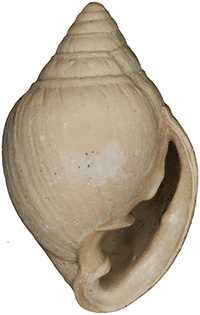Mai 2024: Hollow-shelled snail
Pythiopsis douvillei (Vasseur, 1881)
Cenozoic: middle Eocene, approximately 40 million years old
Saffré near Nantes, France

Pythiopsis douvillei is an Eocene representative of the family Ellobiidae, the so-called hollow-shelled snails. Pythiopsis is a purely fossil genus and includes 17 species and ranges from the Early Paleocene to the Late Eocene, and according to some authors even to the Middle Miocene (approx. 63–15 million years). The worldwide distributed family Ellobiidae includes 240 fossil and 320 living species. With the exception of the thorn snails (Carychiinae), which also occur in cooler latitudes, today’s representatives of the ellobiids are mainly found in the tropical regions of the world. Hollow-shelled snails inhabit the coastal zones along river mouths, mangroves and salt marshes. There they occur in the brackish water of the intertidal area or on land above the splash zone.
The fossil genus Pythiopsis is probably a relative of the living genus Pythia, which is now found primarily in tropical and subtropical rainforests and mangroves of the Indo-Pacific. There the animals live near the waterline, under stones, leaves and in rotten trees as well as on mangrove trees. This also fits with the depositional environment of the region the shell was found in. The Middle Eocene was a global warm period during which mean annual temperatures exceeded those of today’s Earth by around 7–12 °C. At this time, the site of Saffré (today north of Nantes in France) was located along a tropical sea lined with mangrove forests, on the southern edge of the Armorican Massif. Pythiopsis douvillei was part of a highly diverse fauna that included over 1000 species in this region and at that time, with representatives from marine, brackish, freshwater and terrestrial habitats. In addition to the more common snails and mussels, sharks, bony fish, mammals, reptiles, cephalopods, scaphopods, crustaceans, brachiopods, corals, sea urchins and bryozoans are also known from there.
The narrow and toothed aperture of the shell offers, as with recent members of the group, several advantages. On the one hand, it offers protection from predatory crabs and other predators. It also prevents too much soft mud from penetrating the shell and moreover prevents the soft body from drying out.
Thomas A. Neubauer, Munich



